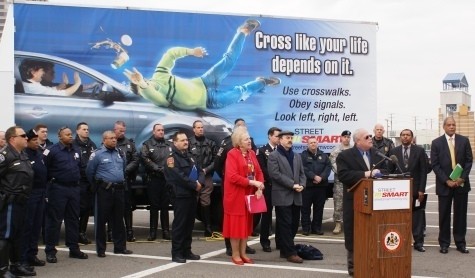How other cities use messaging to make transit cool

Image is a screenshot from the Danish Midttrafik ad.
Ad campaigns in other cities point out the fun and virtue of using transit, while those we see on the Metro in DC mostly warn us about suspicious packages and urge us to be alert for thieves.
As Metro tries to grow and improve, here are some lessons from cities around the world that have found strategies to make taking transit more safe as well as appealing.
Other cities around the world show how transit is cool
Transit systems’ own messaging impact riders’ perceptions. It’s interesting to contrast advertisements about cars with advertisements on or about transit. Many US television ads showcase the glamour and perks of owning a car — typical imagery shows a pristine vehicle winding through a bucolic countryside. Meanwhile, Metro ads mostly warn us to be vigilant and scold us about eating and drinking on the train.
Illustrated 1954 Car Accessory Ad, Carter Carbureter, Elegant Couple Going Out for the Evening by Classic Film licensed under Creative Commons.
Other imagery shows walking as dangerous.
Some cities are addressing this perception problem in creative ways. For example, positive metro advertisements in Barcelona tell users how they are improving their environment, economy, and society by riding, as do ads in Montreal.
"Let's favor public transit" sign in Montreal. Image by the author._800_600_90.jpg)
In Nairobi, privately-owned buses or ‘Matatu-s’ were once associated with crimes, gangs, and reckless driving. Now they’ve become an outdoor moving art experience with the help of social media. These buses bring people together as they jostle to ride on the coolest Matatu.
Custom matatu art featuring Tupac in Nairobi. Image by teakwood licensed under Creative Commons.
The Danes have a lot of fun with buses. Important quote: “The bus driver is cool.”
Toronto's Transit Commission partnered with The National Ballet of Canada:
The US is catching on too
Austin's Capital Metro crowdsourced photos of their regular (charactaristically weird) riders for their 2018 campaign.
Image by Photo courtesy of Capital Metro.
Chicago's Regional Transportation Authority is trying to appeal to younger people in this 2015 ad.
Closer to home, DC's Circulator had a cute selfie campaign in 2015, complete with this party bus photo:
WMATA is dipping its toes into this kind of messaging with its merchandise and advertisements for it that play in some train cars.
WMATA is selling a "Traffic? Nah brah." t-shirt in its shop. 
Positive messaging is no substitute for substance
Of course, what’s around the transit matters too. Another way we can promote safety and enjoyment is by enforcing walkable mixed development around stations. In her iconic book “The Death and Life of Great American Cities,” Jane Jacobs argues that “eyes on the street” are vital for a safe and vibrant urban life. She means not so much police and security cameras, but rather people hanging out at coffee shops, sitting on benches, and looking out their windows.
When I lived in Madrid, I could hop on the metro in the middle of the night after being out and feel safe because the tracks and stations frequently coincided with balconies, cafes, and restaurants, thereby bringing in Jacobs’ eyes on the street to the stops.
Exiting a station in Madrid. Image by the author.
Many metro systems around the world have elevated metro lines (which we can find in the Washington region) with pedestrian-oriented buildings that succeed in integrating their platforms within the streetscape and encourage a busy walkable street. Examples are Schlesisches Tor on the U1 line in Berlin, Bir-Hakeim on line 6 in Paris, and Nanjing Fuxing on the brown line in Taipei.
Perhaps WMATA could adopt some positive storytelling techniques like those found in Barcelona. It could point out how beneficial taking the bus or train is for the environment, and remind riders how nice it is to put on a podcast and relax instead of fighting through a traffic jam.
Readers: What transit campaigns or messaging have you seen abroad that would be useful to adopt here?



